2025 Mahindra XUV 3XO Review: The Ultimate Budget Compact SUV for India?
By Keep It Soft Reviews | Published April 24, 2025
The 2025 Mahindra XUV 3XO is a bold, tech-laden contender in India’s crowded sub-4-meter compact SUV segment, designed to challenge heavyweights like the Tata Nexon, Hyundai Venue, Maruti Suzuki Brezza, and Kia Sonet. Priced from ₹7.49 lakh to ₹15.49 lakh (ex-showroom), it leverages India’s tax-friendly sub-4-meter rule to offer premium features at budget prices. With a 1.2L turbo-petrol engine, level-2 ADAS, and a panoramic sunroof, the XUV 3XO aims to win over urban buyers in Mumbai and families driving to Jaipur. After a week of testing across city streets and highways, we dive into its design, interior, performance, practicality, and value to help you decide if this is India’s best budget compact SUV.
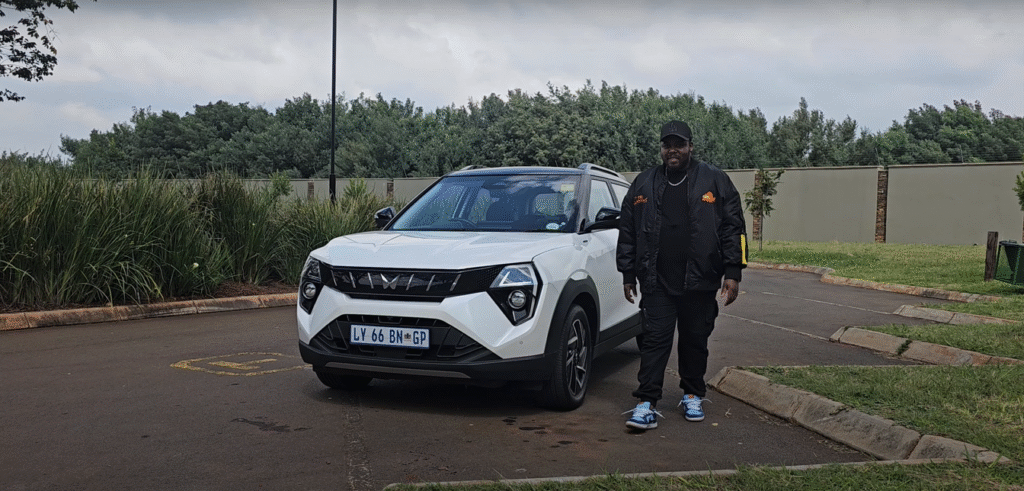
Mahindra XUV 3XO Specs at a Glance
- Price: ₹7.49 lakh–₹15.49 lakh (ex-showroom)
- Engine: 1.2L 3-cylinder turbo-petrol (82 kW, 200 Nm)
- Transmission: 6-speed manual or 6-speed automatic
- Fuel Efficiency: ~13.4 kmpl (sports mode), ~15 kmpl (normal mode)
- Boot Space: 364 L
- Safety: 6 airbags (top variants), level-2 ADAS, 360° camera
- Ground Clearance: 201 mm
- Variants: MX2, MX3, AX5, AX5L, AX7L
- Warranty: 3 years/1,00,000 km (extendable to 5 years)
- Tyres: Goodyear (215/55 R17, diamond-cut alloys)
- Infotainment: 10.25-inch touchscreen, wireless Android Auto, wired Apple CarPlay
- Audio: Harman Kardon 7-speaker system (top variants)
Exterior: Aggressive Styling with a Bold Presence
The XUV 3XO’s boxy, muscular design demands attention, blending rugged charm with modern flair. Its sharp LED DRLs form a continuous strip, flowing into a diamond-embossed grille that proudly displays Mahindra’s new logo—a nod to its premium aspirations. Glossy and hard plastic accents on the front bumper balance style and durability, ideal for India’s dusty rural roads. However, the glossy bits are prone to scuffs, so buyers in Pune’s outskirts should be cautious. The 17-inch diamond-cut alloy wheels, wrapped in Goodyear tyres, elevate its sporty stance, earning compliments for their sleek design.
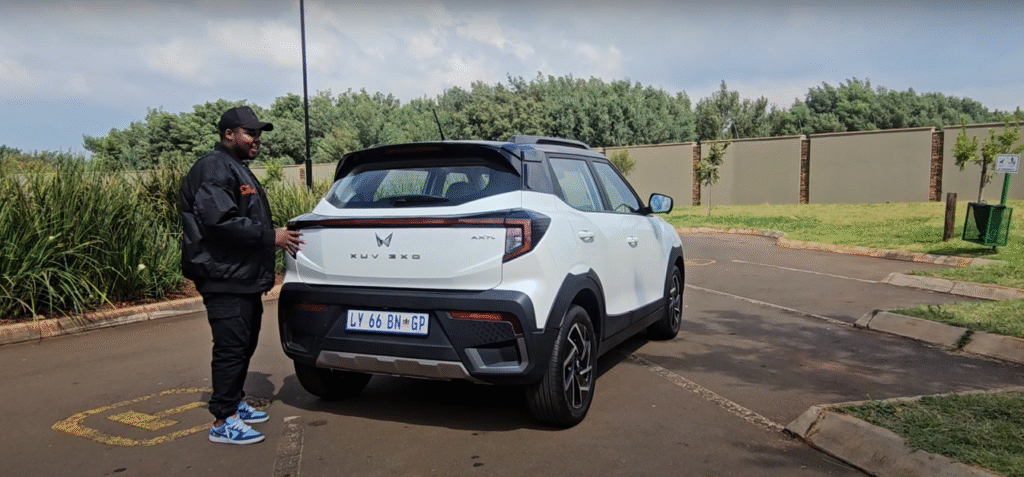
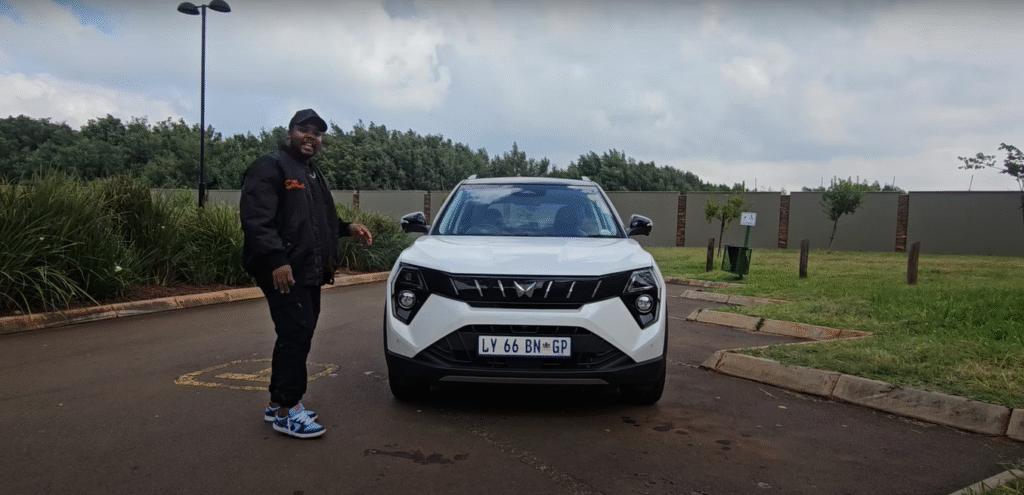
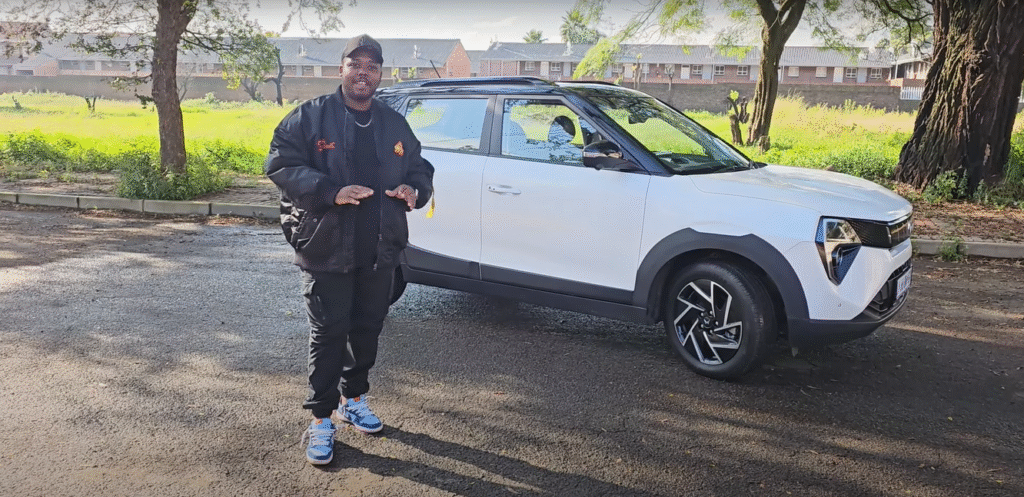
Two-tone color options (e.g., Stealth Black roof with Nebula Blue or Deep Forest Green) add customization, perfect for standing out in Delhi’s traffic. Our test unit’s untinted windows were a privacy concern—visible interiors are a risk in crowded cities, so smash-and-grab tinting is a must for buyers in Bengaluru or Chennai. The full-width LED tail light bar mirrors the front DRLs, maintaining design cohesion, but the rear feels flat, almost like it “reversed into a wall.” The rear camera, hidden under the boot handle, is a clever touch, and the 201 mm ground clearance ensures confidence on potholed roads to Lonavala.
The side profile features rugged plastic cladding around doors, protecting against mud and scratches—a practical choice for monsoon drives in Kerala. Proper door handles (not flush) and large windows enhance accessibility and visibility, though the bright interior lights exacerbate the tinting issue at night. The AX7L badge and automatic sticker on higher trims add a premium feel, but the faux grille stripes may polarize buyers seeking understated elegance.
Drawbacks: The rear design lacks character, untinted windows reduce privacy, and faux grille stripes may not appeal to all. Glossy plastics risk scuffing on rough terrain.
Interior: Tech-Savvy and Premium, but Compact
The XUV 3XO’s interior is a highlight, especially in the AX7L, where Mahindra’s Adrenox infotainment system shines. The 10.25-inch touchscreen and 10.25-inch HD driver display are intuitive, supporting wireless Android Auto and wired Apple CarPlay. A standout feature is the full-screen Android Auto maps on the driver display, showing navigation alongside driving data (e.g., speed, fuel economy)—a game-changer for navigating Kolkata’s chaotic streets without glancing away. Physical buttons for climate control, ADAS toggles, and beep deactivation ensure easy access, unlike touchscreen-heavy rivals like the Kia Sonet.
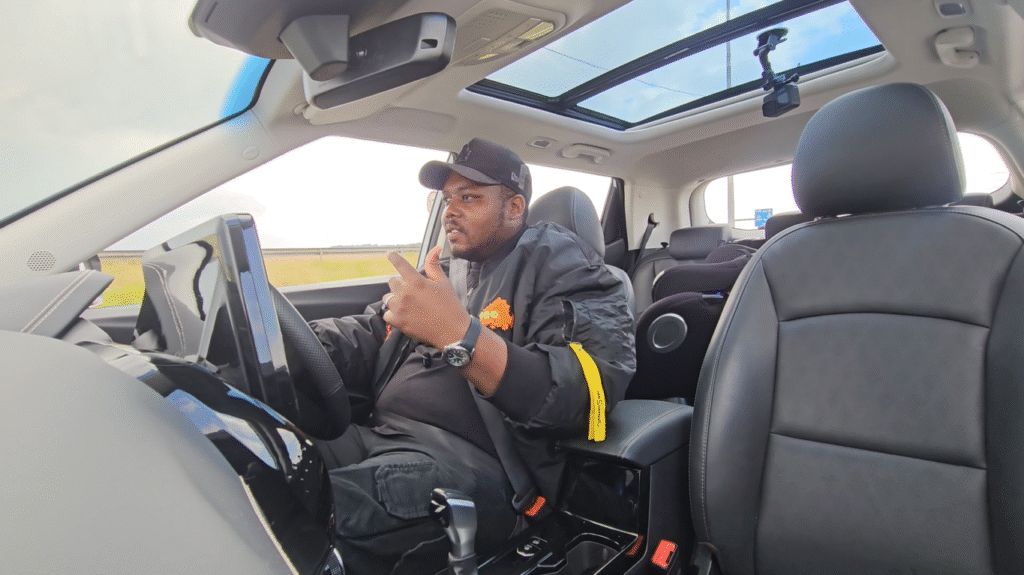
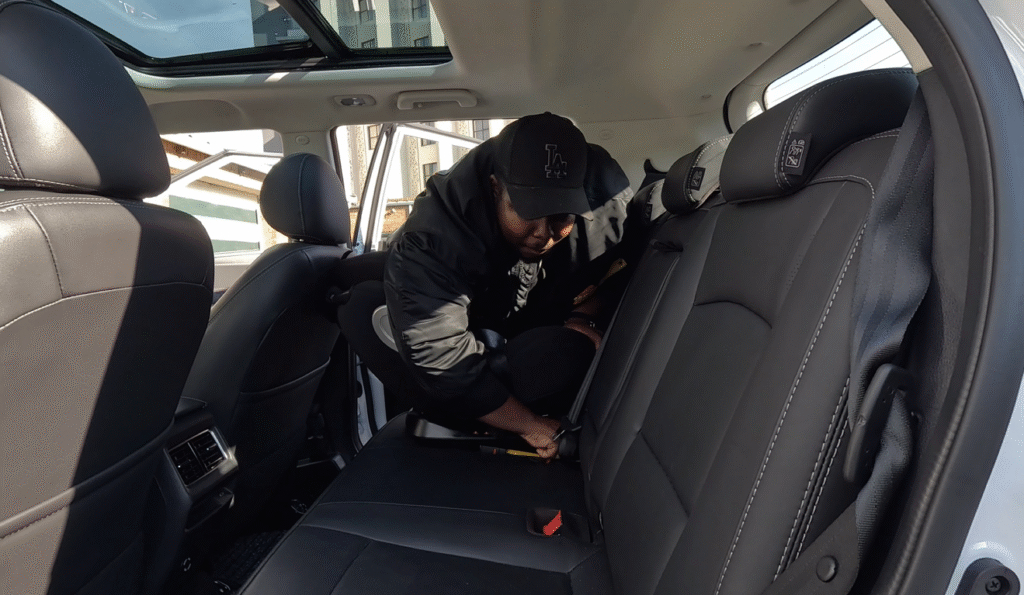
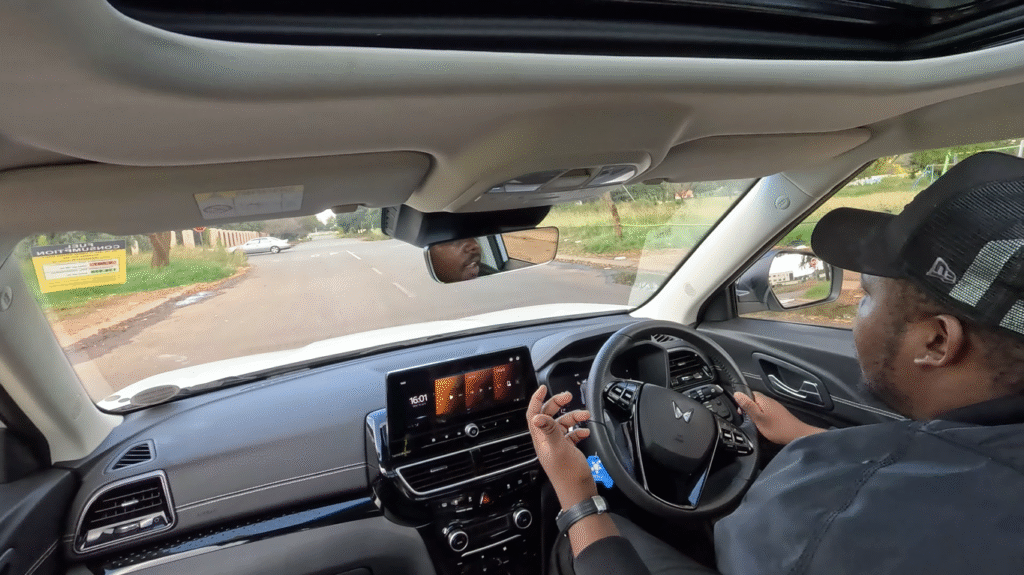
The AX7L features soft-touch materials, white stitching, and a diamond pattern on seats, dash, and door pads, creating a premium ambiance that rivals the Hyundai Venue’s cabin. Leatherette seats with red accents are supportive for average builds (up to 179 cm) but may feel snug for larger drivers, especially on long drives to Goa. The panoramic sunroof (standard from MX3, full-length in AX7L) brightens the cabin, but the light-colored headliner shows dirt easily—our test unit had marks at just 18,000 km. Storage includes two bottle holders (small and large), a wireless charging pad (65W fast charging, blue LED for Samsung users), and dual cup holders, but the center console fills up quickly with keys, wallet, and glasses.
The rear seats offer decent legroom for a 179 cm passenger but lack under-thigh support, and headroom is tight in the AX7L due to the panoramic roof—taller passengers (above 180 cm) may brush the ceiling. Dual-zone AC, two USB ports, and a Harman Kardon 7-speaker system (with subwoofer) cater to families, but the audio quality is decent rather than exceptional, trailing the Sonet’s Bose setup. ISOFIX points ensure child safety, but clipping a baby seat is tricky due to seatbelt interference—a frustration for parents in Ahmedabad. Road and wind noise at 100 km/h are noticeable, especially on windy highways, making the Nexon’s quieter cabin more appealing for long trips.
Entry-level variants (MX2, MX3) use harder plastics and lack the sunroof or driver display, but even the MX3 automatic (₹9.49 lakh) feels well-equipped with a touchscreen and sunroof. The white headliner and bright interior lights are consistent across trims, so tinting is essential for privacy.
Drawbacks: Tight rear headroom, noisy cabin at highway speeds, and limited storage space. The sound system and baby seat installation could be better.
Performance: Lively and Fun, but Not Silent
The XUV 3XO’s 1.2L 3-cylinder turbo-petrol engine (82 kW, 200 Nm) is a standout, delivering peppy performance across all variants. Paired with a 6-speed automatic (or manual), it feels eager, especially in Zoom (sports) mode, where the throttle is sharp, perfect for overtaking on the Mumbai-Pune Expressway. Our test in sports mode yielded 13.4 kmpl (~7.4 L/100 km), respectable for a 5-seater SUV with 201 mm ground clearance. In Zap (normal) mode, expect closer to 15 kmpl in city driving, competitive with the Brezza but trailing the Venue’s efficiency.
The level-2 ADAS (adaptive cruise control, lane-keep assist) is a segment-first, activated via steering wheel buttons for ease, unlike the Sonet’s menu-driven systems. The lane-keep assist is non-intrusive, gently correcting drift on highways like the Delhi-Agra Expressway, while adaptive cruise maintains smooth pacing in traffic. The suspension handles potholes well, though minor bumps are felt on rural roads to Udaipur. Zoom mode transforms the XUV 3XO into a fun, responsive ride, with a subtle V6-like engine undertone (not artificial) adding character. However, wind and road noise at 100 km/h detract from refinement, and the brakes could feel sharper for spirited driving.
The same engine across variants ensures consistent performance, so even the base MX2 feels lively. The 6-speed automatic shifts smoothly, though it’s less refined than the Nexon’s AMT in stop-go traffic. For buyers in Hyderabad seeking fun without sacrificing fuel economy, the XUV 3XO delivers, but those prioritizing a silent cabin may prefer the Venue or Nexon.
Drawbacks: Noisy at highway speeds, and brakes lack bite. No diesel option limits appeal for high-mileage drivers compared to the Nexon.
Practicality: Family-Friendly but Space-Constrained
The XUV 3XO’s 364 L boot is modest, fitting a few suitcases but trailing the Tata Nexon (382 L), Hyundai Venue (350 L), and Kia Sonet (392 L). A high-loading lip and tire repair kit (no spare wheel) are drawbacks for long trips to the Himalayas—punctures on rural roads could be an issue. Folding the 60:40 rear seats expands space, but the panoramic roof reduces rear headroom, impacting taller passengers. ISOFIX points and a proper rear seatbelt (not airplane-style) ensure child safety, but baby seat installation is fiddly due to seatbelt interference.
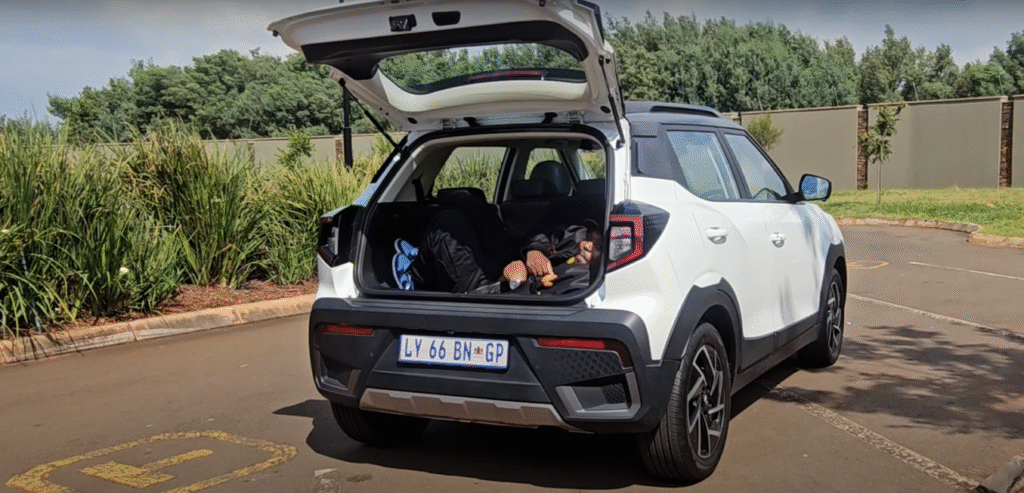
Safety is a strong suit, with 6 airbags, 360° camera, ABS, ESC, and level-2 ADAS in top variants, matching the Nexon’s 5-star GNCAP rating. The rear camera and parking sensors aid parking in tight Mumbai markets, while the 201 mm ground clearance tackles monsoon-flooded streets in Chennai. Storage includes door bins, an armrest with a lean-friendly design, and a 65W charging pad, but the center console is small, filling up with essentials like keys and sunglasses.
At ₹7.49 lakh–₹15.49 lakh, the XUV 3XO is affordable. A 42 L tank costs ~₹3,360 (at ₹80/L), with two tanks monthly (~₹6,720) plus insurance (~₹3,000), totaling ~₹12,000. This suits earners of ₹25,000–₹35,000 monthly, per industry affordability metrics. Mahindra’s service network (over 600 touchpoints) ensures accessibility in tier-2 cities like Bhopal.
Drawbacks: Small boot, no spare wheel, and tight rear space limit family practicality. Competitors offer larger cargo areas and easier child seat setups.
Variants and Value
The XUV 3XO comes in five variants: MX2, MX3, AX5, AX5L, and AX7L, with manual and automatic options up to AX5L; the AX7L is automatic-only. Here’s a breakdown:
- MX2 (₹7.49 lakh): Steel wheels, basic seats, no touchscreen—ideal for budget buyers.
- MX3 (₹9.49 lakh, automatic): Adds 10.25-inch touchscreen, sunroof, wireless Android Auto—best value.
- AX5 (₹10.99 lakh): 10.25-inch HD driver display, alloy wheels, dual-zone AC.
- AX5L (₹12.49 lakh): Level-2 ADAS, 360° camera, enhanced safety.
- AX7L (₹15.49 lakh): Panoramic sunroof, Harman Kardon audio, leatherette seats—premium but pricey.
The MX3 automatic offers the best bang for buck, balancing tech (sunroof, touchscreen) and affordability. The AX7L competes with the Chery Tiggo 7 Pro, Haval Jolion, and Hyundai Creta, but its 1.2L engine feels underpowered against their stronger motors (e.g., Nexon’s 88.2 kW diesel).
Comparisons: How It Stacks Up
- Tata Nexon (₹8 lakh–₹15.8 lakh): Larger boot (382 L), quieter cabin, diesel option, but less intuitive infotainment. XUV 3XO wins on ADAS and driver display maps.
- Hyundai Venue (₹7.94 lakh–₹13.5 lakh): Smoother ride, better insulation, but no ADAS or panoramic roof. XUV 3XO offers more tech.
- Maruti Suzuki Brezza (₹8.34 lakh–₹14.14 lakh): Fuel-efficient, reliable, but dated tech. XUV 3XO’s modern features shine.
- Kia Sonet (₹7.99 lakh–₹15.75 lakh): Premium cabin, Bose audio, but smaller sunroof. XUV 3XO’s ADAS and value edge out.
For buyers in Gurgaon prioritizing tech and style, the XUV 3XO’s mid-spec variants (MX3, AX5) outshine rivals. Those needing space or diesel power may prefer the Nexon or Sonet.
Final Verdict: Should You Buy the Mahindra XUV 3XO in India?
The 2025 Mahindra XUV 3XO is a tech-savvy, stylish compact SUV that delivers exceptional value under ₹10 lakh, with a lively 1.2L turbo engine, level-2 ADAS, and a premium interior. Its MX3 and AX5 variants are ideal for young buyers in Bengaluru or small families in Ahmedabad, offering features like a panoramic sunroof and 10.25-inch screens at budget prices. However, limited boot space, tight rear headroom, and highway noise make it less practical for large families or long drives to Rishikesh compared to the Tata Nexon or Kia Sonet.
Who Should Buy It?
- Young professionals seeking tech (ADAS, Android Auto maps) under ₹10 lakh.
- Urban drivers need a stylish, compact SUV for city commutes.
- Small families are okay with modest boot and rear space.
Who Should Look Elsewhere?
- Large families require more cargo and rear room.
- Buyers are prioritizing a quiet cabin for highway trips.
- Those needing diesel power or a spare wheel.

